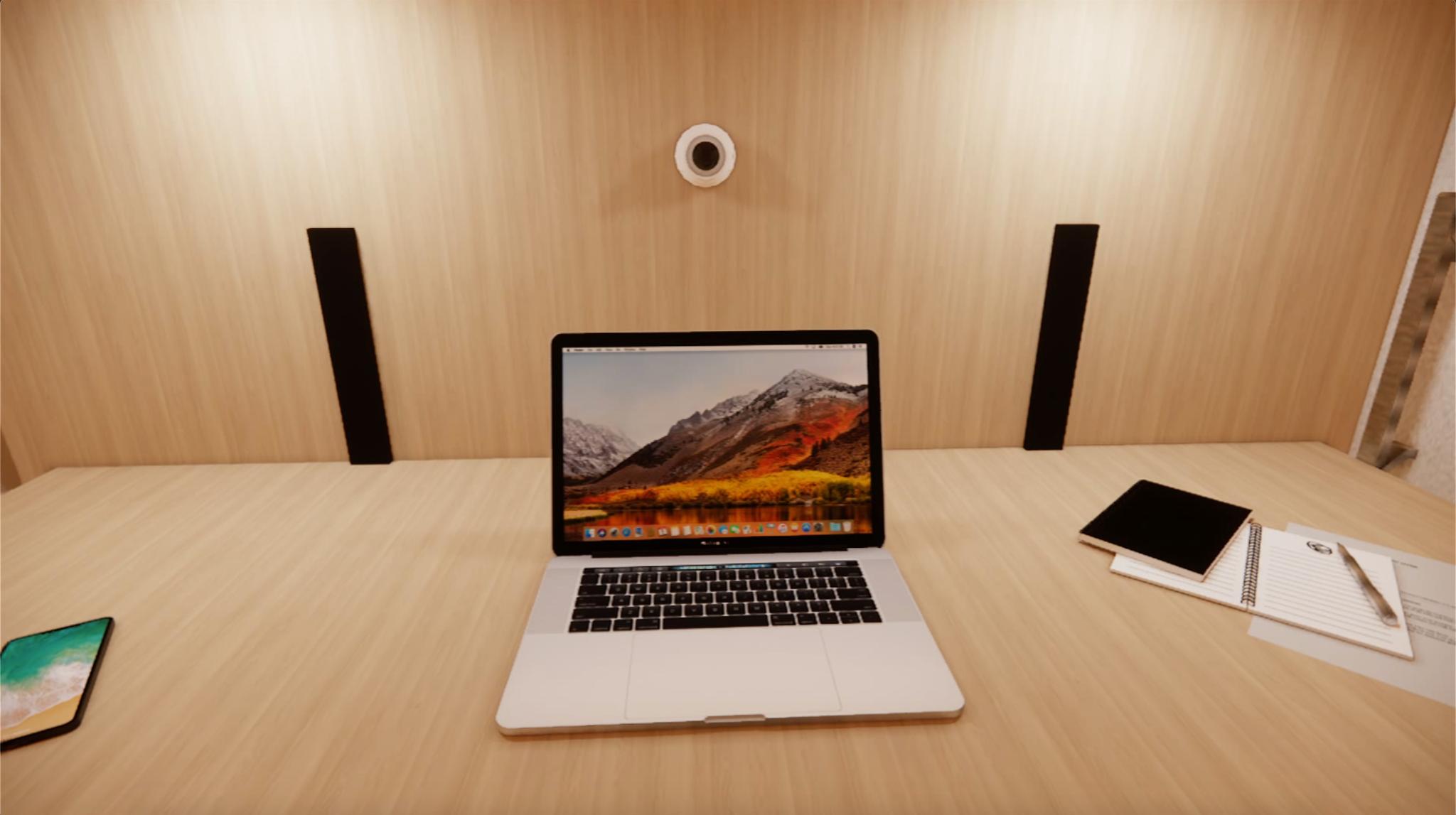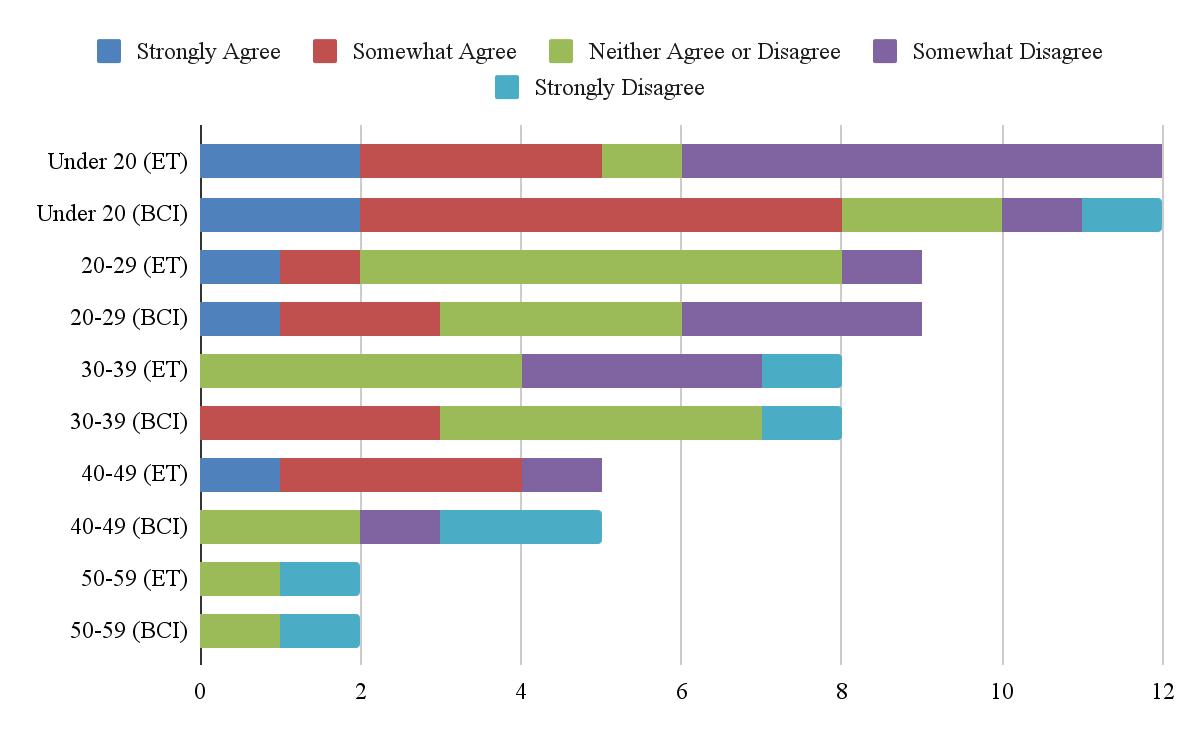Abstract
Eyetrackingandbrain-computerinterface(BCI)technologiesareexamplesoftwoinnovative informationtechnologiesthatattractgreatattentionfromsmarttechnologyusersinrecentyears. Users’attitudesandpreferencesforeyetrackingandbrain-computerinterfacesareessential factorstotakeintoconsiderationwhendesigningsystemsthatusethesetechnologies.Current researchandliteratureontheprivacyissuesregardingthetwotechnologiesarealsolimitedto thetechnologicalaspect,insteadoffromtheusers’perspective.Tothisend,wedesigneda surveyforunderstandinghowpotentialusersofemergingtechnologiesperceivetheprivacyrisk andtheirbehavioralintentionsforusingeyetrackingandBCItechnologies.Thesurveyresults revealthatpotentialusersshowmoretrustandhaverelativelymorepositiveattitudestoward usingBCItechnology;however,itisimportanttonotethatthereisgreatcomplexitywithinthe users’responsesthatsuggestfurtherinvestigationintothefactorsthatcontributetousers’ perceivedriskandprivacyconcernsonspecifictechnologies.
1Introduction
Inrecentyears,developmentsandadvancesininformationtechnologieshaveenabledthewider applicationsofsmarttechnologiesandbrain-computerinterfaces(BCI)invariousfields. Assistivetechnologieshavealsogrownconsiderablytoenhanceworking,learning,anddaily livingforindividualswithdisabilities.Withinthesecategories,smarthometechnologiessuchas GoogleNestLearningThermostat,SamsungSmartThings,andPhilipsHueSmartLighting, rehabilitativetechnologiesthatareprovidedforpatientssufferingfromphysicalorcognitive impairments,andwearabletechnologyforpersonalhealthmanagementareexamplesofspecific innovationsthathavegainedgreatattentionfrompotentialusers(Cericola,2021).However, despitemoreapplicationsandtechnologicaladvancements,informationtechnologiesstillface manychallengesmeetingthedemandsoftheusersduetoprivacyrelatedissues(Chaudharyand Agrawal,2019).Researchershavenotexplicitlyaddressedtheprivacyconcernsandattitudes fromtheusers’perspective,whichisessentialtotheapplicationofinformationtechnologiesin allfields.
2Background
2.1Eyetrackingtechnology
Eyetrackingtechnologyreferstosystemsthatutilizestheprocessofmeasuringusers’gaze points,whichdiscloseswhereoneislooking.Measurementsofone’sgazepointrelyon
algorithms,techniques,andIoTtoolssuchasprojectorsandcamerastotrackeyedirectionand position(Klaib,AhmadF.etal.2020).Asuccessfuleyetrackingdevicecannotewherethe users’arelookingatandthesequencethatshiftsbetweendifferentgazepositionsatanygiven time.Ashumansinvestigatevisualinformation,cuessuchasskimming,glancing,andpausing onspecificareas,andrapidmovementsduringcertaintimesareprovidedtotheeyetracking systeminrealtime(Hosfelt&Shadowen2020).
Fig.1ProcessofEyeTracking

Sincetheearly1900swhenmethodsofmeasuringone’sgazewerefirstexplored,significant advanceshavebeenmadeintheunderstandingofeyemovementmeasurements(Kroger,J.L.et al.2019).Recenttechnologicaldevelopmentsenabledtremendousgrowthinthesensor technologyfield,contributingtoinnovativeeyetrackingsolutionsthatareefficientandeasyto use.Theapplicationofeyetrackingtechnologiesexistsacrossvariousfieldssuchasresearch, marketing,anddesign.Notableexamplesofpopularrecentadoptionsincludethebroadinclusion invirtualreality(VR)headsetsandapplications(Hosfelt&Shadowen2020)andstudyingthe participants’eyemovementswhiletheyareansweringquestionsorperformingcertaintasks.
Withincreasingapplicationsofeyetrackingtechnology,therearealsogrowingconcerns regardingtheprivacylossfromsensorsandcameras.Users’eyemovementsandbehaviorsare alsoknownasgazedatatoeyetrackers.Gazedataisnotonlyuniquetoeachindividualbutalso containssensitiveattributesabouttheusersuchasphysicalcharacteristicslikeage,ethnicity, bodyweight,etc.andsocialcharacteristicslikefears,sexualpreference,andemotionalstate (Lieblingetal.2014).Theuniquenessofanindividual'sgazedataallowsfortheapplicationof eyetrackingtechnologyinsecurityprogramsandforauthenticationpurposes(Katsini,Christina etal.2020).However,literatureandresearchoneyetrackingandgazedatahasbeenprimarily limitedtoitsinclusioninotherapplicationsinsteadofdivingintousers’obviousconcernsover theirprivacylossduringinteractionwitheyetrackingdevicesorsystems(Kroger,J.L.etal. 2019).Arelevantstudyoneyetrackingandprivacycompletedin2014thatfocusedon
reviewingcurrentresearchineyetrackingcametotheconclusionthatmoreattentionneedstobe divestedtotheprotectionofgazedatabypolicymakersandpractitioners(Liebling,2014).Users’ concernsandtheireffectsonusers’behavioralintentionsforusingeyetrackingtechnologies haveremainedunanswered.
2.2Brain-ComputerInterfaceTechnology
Brain-computerinterface(BCI)referstoasystemthatusesbrainsignalsasinputdataand translatestheinformationtoalanguagethatcomputersunderstandandcanproduceresponses throughexternaloutputdevicesbasedontheacquiredbraindata.Itishighlyregardedasan emergingalternativesolutiontocommunicationandcontrolofthebrain(Chaudharyand Agrawal,2019).Therecordingandmeasurementofbrainactivityareusuallycarriedoutbya devicethatutilizeselectroencephalography,alsoknownasanEEGdevice.BCItechnology establishesanuninterruptedconnectionbetweenthebrainandtheexternaldevice,anexciting qualitythatattractsgreatattentionfromhealthcareandthefieldofassistivetechnology
Fig.2WorkingofBrain-ComputerInterface
Initiallydevelopedforbiomedicalapplications,BCItechnologyhasbeenappliedtomany assistivedevices,increasingusers’qualityoflifegreatly(Mudgaletal.,2020).Forphysically disabledpatients,theuseofBCItechnologypromotestherestorationofbothphysicalmovement andcommunicationability(RaoandSchere,2010).Arecentstudyfrom2021explorestheuseof avisualBCIforpatientswithamyotrophiclateralsclerosis,aidingtheircommunicationabilities (Verbaarschotetal.,2021).Duringthepastfewyears,therehasalsobeenincreasinginterestin thewiderapplicationofBCItechnologyforhealthyindividuals(Mudgaletal.,2020).The non-medicalusesofBCIaremostcommonlybroughtupinissueslikeworkplaceperformance, mentalhealth,andmediaapplications(Blankertzetal.,2010).

BCItechnology,similartotheissuesthatusershavewitheyetracking,exhibitsgreatprivacy concernsasmoreapplicationsandinnovationshavebeentakingplaceinrecentyears.Current researchandstudiesontheprivacy,security,andtrust-relatedproblemsmostlyaimtofind solutionsforthetechnologicaldesignofBCI.Forexample,astudyfrom2014proposedatoolto blockthepossibilityof“side-channelextractionofusers’privateinformation”fromthird-parties (BonaciandChizeck,2019).Thereisanoticeabledeficiencyregardingtheresearchdoneonhow theusersperceivetheirpotentiallossofprivacyandrelatedbehavioralintentionsforusingBCI technology.
3Methods
Thegoalofoursmartlightingpodistoimproveconcentrationandfocuslevelswhilecompleting cognitivetasks.Inordertoachievethisgoal,ourinvestigationledustolookintohowusers’ attitudesandpreferenceswouldaffectthepod’sbiometricmethod.Thesurveyintroducedinitial researchtodeterminewhichmethodwouldbestsuitthedemographicofusersthatthepodis directedtowards,bytestingourhypothesisonuserpreferences.Wegaveparticipantsascenario inwhichtheycouldvisualizescenariosinthesurveybetweeneyetrackingandBCIasshownin the4Resultssection.Onlythebiometricmethodchangedbetweenthescenariosandeverything elseaboutthepoddesignwaskeptthesame.Detailsofthepod’sdesignareexplainedfurtherin Section3.1.
3.1Design

Fig.4Interiorlookofpod

Fig.5Interiorlookofpod
Thepodwasmeanttobeplacedinpublicenvironmentsincludinglibraries,lounges,offices,etc. Ourinitialprototypewasrenderedhowweenvisioneditasafinaldesign.Themainstructure wouldbemadeoutofwoodandwouldbesolidontwowallsaswellasthefloorandceilingto maintainasemi-enclosedspace.Thepodcanbeenteredfromeithersidethroughasetofsliding glassdoors.Tomaintaintheuser’sprivacytheyhavetheoptionofadjustingthesettingofthe glasstomakeitfrostedandthereforemoreopaque.Insidethepod,thereisanadjustabledesk andchair.Thedeskisattachedtotheshorterendofthepodandcanberaisedandloweredtoany height.Onthetallerwall,thereareventilationpanelstoallowforanaturalcirculationofair. Thesepanelscanalsobeopenedandclosedtoadjusttothecirculationandoutsidenoiselevels. Thetechnologyofthepodwouldtakeoneoftworoutesdependingonthefinalbiometricmethod used.Withtheeyetrackingsoftwareacamerawillbecenteredaroundtheuser’seyeline.The camerawoulddetectthemovementsoftheeyefromthecenterofthedesk(whichcontainsthe higherprioritytask).Ifauser’seyemovementsarefrequentlyawayfromthecenterorforlong durationsoftime,thelightingwouldautomaticallyadjusttoabrightersettinginordertoincrease attentionanddirecttheuserbacktowardstheirmaintask.Afterasetamountoftime,thelighting willflashbrieflytoanotherspecifiedcolortoindicatethattheusershouldtakeabreak.
TheBCImethodwouldincludeanEEGheadsetthatuserswearwhileusingthepod.Theheadset wouldmeasuretheprefrontalcortexofthebraintomonitorattentionlevels.Iftheleveldropped toalowpointforanextendedperiodoftime,thelightingwouldadjustsimilarlytohowtheeye trackingsoftwarewould.Iftheuserisfocusedforasetamountoftime,thelightingwouldalso indicateacolorchangetoindicateabreakfortheuser

3.2Procedure
Throughamethodofconveniencesampling,thesurveywasdistributedthroughmanyplatforms suchase-mails,socialmedia,anduniversitygroupoutreachinordertoreachasmany respondentsaspossible.AsamplesizeofN=36wascollectedforanalysis;whichincludes
individualsofvariousbackgroundsasshowninTable1.Participantswereabletofilloutthe surveydigitallythroughadistributedlink.
Theoverallsurveywassplitintofourportionsforthemtocomplete.Sectiononeconsistedofthe demographicandIOTscalequestions.Thesequestionswerepresentedtoparticipantstogetan overallunderstandingoftheirbackgroundwithsmarttechnologydevices.Thesecondsection consistedofavideoforeyetrackingandavideoforBCI.Afterwatchingeachvideo,participants wereaskedaseriesofquestionsrelatingtotheirattitudesandpreferencestowardstherespective biometricmethod.Thethirdsectioncontainedcomparisonquestionsthatwouldaskparticipants tochoosewhichbiometricmethodbestsuitedthestatementgiven.Thefourthandfinalsection askedparticipantsaboutthepodandtheirattitudestowardsit.
3.3ParticipantDemographics
Thesociodemographicvariablesusedinthesurveyareasfollows:
Gender:Weincludedgenderasademographicvariabletoseeiftherearedifferencesinthe attitudeandpreferenceofeyetrackingandBCIbiometricmethodsamongdifferentgenders.The genderbreakdowninthestudyis47.22%femaleand52.78%male.Ourgoalwastocollecta significantamountofdatafromeachgender Theoveralldemographicvariablewasfairly balanced.
Age:Withage,thereisgenerallyanegativecorrelationwithacceptanceofnewertechnologyand thereforethisdemographicvariablewasincluded.Participantswereclassifiedintofiveage groups(under20,20-29,30-39,40-49,and50-59)basedonthesampleofpeoplewereceived datafrom.
Education:Theremaybeassumptionsthateducatedpeoplewhoareexposedtoadvancedand newertechnologymightaccepttechnologymoreeagerlythanlesseducatedpeople.However, withanincreaseinuser-friendlytechnology,thismaynolongerbethecase.
Familiaritywithsmarttechnology:Bygaugingparticipants’familiaritywithsmarttechnology, wegaininformationonwhetherthey’refamiliarwiththeirfunctionsineverydayuse.
Count N%
Gender Female 17 4722% Male 19 52.78%
Age (Average:28.58) Under20 12 33.33% 20-29 9 25.00% 30-39 8 22.22% 40-49 5 13.89% 50-59 2 556%
HighestLevelofEducation Master's 7 1944%
Bachelor's 9 2500%
Somecollege 15 41.67% HighSchool 3 8.33% LessthanHighSchool 2 5.56%
Table1:Demographicinformationofparticipants(N=36)

4Results
Inthefirstsectionofthesurvey,participantswereaskedhowfrequentlytheyusedIoTdevices. ThedatacollectedisshowninFig.6anddemonstratesthateveryonewasfamiliarwithsmart phonesandcomputers(100%).Amajorityofpeople(61.1%)alsousedwearabletechnologies (Themostfrequentdeviceswereairpods).Theusageofsmarthomedevicesandsmart applianceswerefairlysplitbetweenthefrequencyofuse.
Fig.6FrequencyUsageofIoTDevices
Inordertoknowaparticipant’sattitudesandpreferences,a5-pointLikertscalewasused (1=StronglyAgreeto5=StronglyDisagree).Ameanandstandarddeviationwasthencalculated foreachstatement.Inthefirstsectionofthesurvey,participantsweregivenstatementsabout theirattitudestowardssmarttechnologyingeneral(Table2).Mostpeoplestronglyagreedor somewhatagreedwiththestatement,“Itiseasyformetoquicklybecomefamiliarwithnew smartdevices.”(1.417).However,thestatementthatusesweremorelikelytodisagreewithwas
“Itrustsmarttechnologyingeneral.”(2.583).Overall,participantsfeltmorepositiveaboutsmart technologyasmostagreedwithallofthestatements.
Constructs Item Mean SD Effort
Expectancy
Itiseasyformetoquicklybecomefamiliarwithnewsmartdevices. 1.417 0.500 Ifindsmarthomesystemseasytouse. 2.028 0.845 Performance Expectancy Usinghomeautomationtechnologywouldimprovemyqualityoflife 2000 0874 Usingsmartlearningtechnologywouldmakestudyingandschooleasier 1778 0637 Satisfaction I'mcontentwiththewayshumansinteractwithsmarttechnologycurrently 2389 1128 I'mhappywithwhatsmarttechnologycandoforus 1750 1025 Trust Itrustsmarttechnologyingeneral. 2.583 1.251
Table2:Attitudestowardssmarttechnology
Inthesecondsectionofthesurvey,usersweregivenadescriptionandvideoabouteyetracking andBCIinthecontextofthepoddesign.Afterwatchingeachvideo,participantswerethen givenstatementsabouteachrespectivebiometricmethod(asshowninTable3).Usingthesame Likertscale,themeanandstandarddeviationofeachstatementwascalculated.At-testwasused todetermineifthereweresignificantdifferencesinattitudestowardseitherofthebiometric measures.Onlythreestatementsprovedtobestatisticallysignificant.“Ithinkthesystemiseasy touse.”(1.500eyetrackingand1.861BCI)undertheSUSscaleshowedapreferenceforEye trackingbeingeasiertouse.However,onaveragethestatement“Ifindthesystemunnecessarily complex”showedthatpeoplethoughteyetrackingwasmorecomplexbutthisstatementwasnot statisticallysignificant.Withbehavioralintention,“Iplantousetechnologythattracksmy(eye movements/braindata)showedahigherpreferencetowardsusingBCIinthefuture(3.00eye trackingand1.178BCI).Underperceivedrisk,“Interactingwithasmartsystemthatanalyzes my(eyemovementsandgazepoints/braindata)”showedthatparticipantsfeltmoreatriskusing theeyetrackingmethod(2.000eyetrackingand2.944BCI).
Constructs Item
SUS Scale
Trust
Behavioral Intention
EyeTracking BCI
Mean SD Mean SD T-Test
1.500 0.561 1.861 0.798 0.007 Ifindthesystemunnecessarilycomplex. 3.250 1.360 3.083 1.156 0.181
Ithinkthesystemiseasytouse.
Itrustsmarttechnologythattracksmy(eye movements/braindata) 2.611 1.103 2.917 1.156 0.122
Iplantousetechnologythattracksmy(eye movements/braindata)inthefuture 3000 1095 2389 1178 0015
AssumingIhadaccesstoasmartsystemthatanalyzes myeyemovementsandgazepoints,Iintendtouseit. 2.139 1.018 2.417 1.180 0.097
Perceived Risk
Ithinkusingtechnologythattracksmy(eye movements/braindata)putsmyprivacyatrisk.
Interactingwithasmartsystemthatanalyzesmy(eye movementsandgazepoints/braindata)exposesmeto anoverallrisk.
I'mhesitanttosharemypersonaldata(withasmart systemthatincludesacamera/wearinganEEG headset).
2.528 1.000 2.583 1.105 0.389
2.000 0.956 2.944 1.170 0.001
2.917 0.996 2.917 1.228 0.500
Table3:AttitudestowardsEyeTrackingandBCI
Foreachstatementthatwasstatisticallysignificant,ananalysisofvariance(ANOVA)testwas performedtoanalyzepreferencesabouteyetrackingandBCIbetweentheageoftheparticipants usingα=0.05.Thetestwasperformedoneachbiometricmethodforeachstatement.With“I thinkthesystemiseasytouse.”,therewasnostatisticallysignificantdifferencebetweenage groupsandtheirattitudestowardsthestatement(P-valueeyetracking=0.39093andP-value BCI=0.24227).Theunder20agegrouprespondedmorestronglytowardseyetracking, agreeingthatthesystemiseasiertouse.However,acrossotheragegroupsitwasafairlyequal responseasshowninFigure7.
Fig.7Ithinkthesystemiseasytouse.

With“Iplantousetechnologythattracksmy(eyemovements/braindata)inthefuture.”,there wasnostatisticallysignificantdifferencebetweenagegroupsandtheirattitudestowardsthe statement(P-valueeyetracking=0.10881andP-valueBCI=0.07786.).Everyagegroupexcept the30-39groupweremorelikelytoplantouseeyetrackingtechnologyinthefutureoverBCI asshowninFigure8.
Fig.8Iplantousetechnologythattracksmy(eyemovements/braindata)inthefuture.
With“Interactingwithasmartsystemthatanalyzesmy(eyemovementsandgazepoints/brain data)exposesmetoanoverallrisk.”,therewasnostatisticallysignificantdifferencebetweenage groupsandtheirattitudestowardsthestatementforeyetracking(P-value=0.07952).However, thestatementforBCIshowedstatisticalsignificancebetweengroups(P-value=0.04802).Older agegroupssuchasthe40-49and50-59feltthatBCIcouldexposethemtoanoverallrisk(40-49 =1.6and50-59=1.5).TheyoungeragegroupssuchasUnder20and20-29feltthatBCIwas lesslikelytoexposethemtoanoverallrisk(Under20=2.75and20-29=2.556).The30-39age groupfelttheleastlikelythatBCIwouldexposethemtoarisk(3.25)asshowninFigure9.

Fig.9Interactingwithasmartsystemthatanalyzes my(eyemovementsandgazepoints/brain data)exposesmetoanoverallrisk.
Thethirdsectionofthesurvey,participantsweregivencomparisonstatementsasshowninTable 4.Abinomialtestwasperformedtodetermineiftherewasahigherpreferenceforeither biometricmethod.Theonlystatementthatprovedstatisticallysignificantwas“Whichtypeof smarttechnologydoyouseeyourselfinteractingwithmoreinthefuture?”(EyeTracking= 69.4%andBCI=30.6%).

Constructs Item
Behavioral Intention
Whichtypeofsmarttechnologywouldyouprefer tousetomeasureyourattentionlevelswhile usingthestudypod?
Whichtypeofsmarttechnologydoyousee yourselfinteractingwithmoreinthefuture?
Whichtypeofinteractiondoyouseeyourself usingforlongerdurationeachtime?
Whichtypeofsmarttechnologyareyoumore likelytouseforstudyingorworkingeneral?
Whichtypeofsmarttechnologyareyoumore likelytouseathome?
18 18 0.500 0.500 1.000
25 11 0694 0306 0029
19 17 0.528 0.472 0.868
18 18 0.500 0.500 1.000
18 18 0500 0500 1000
SUS Scale
Social
Whichtypeofsmartsystemdoyouthinkiseasier touse?
Whichtypeofsmarttechnologyareyoumore likelytorecommendtoothers?
Whichtypeofsmarttechnologyismorelikelyto beusedbypeoplewithphysicaldisabilities?
Whichtypeofinteractiondoyouseetheelderly populationusetohelpthembettercontrolthe environment?
16 20 0.444 0.556 0.618
18 18 0.500 0.500 1.000
15 21 0417 0583 0405
21 15 0583 0417 0405
Privacy
Whichtypeofdatawouldyoubemorelikelyto sharewithsmartsystems?
Whichtypeofsmarttechnologywouldyoutrust moreintermsofyourprivacy?
17 19 0.472 0.528 0.868
19 16 0.543 0.457 0.736
Whichtypeofsmarttechnologydoyouthinkis morelikelytoexposeyoutoanoverallrisk? 15 19 0441 0559 0608
Table4:ComparisonStatements
With“Whichtypeofsmarttechnologydoyouseeyourselfinteractingwithmoreinthefuture?”, therewasnostatisticallysignificantdifferencebetweenagegroupsandtheirattitudestowards thestatement(P-value=0.39511).Theyoungeragegroupsfrom39andunderpreferredBCI overeyetrackingwhiletheolderagegroupsfrom40andoverpreferredeyetrackingasshown inFigure10.
Fig.10Whichtypeofsmarttechnologydoyouseeyourselfinteractingwithmoreinthefuture?

ThefinalsectionofthesurveyincludedstatementsaboutthepodasshowninTable5.The statement“Wouldyourecommendthepodtoafriend?”showedstatisticalsignificanceinaT-test (P-value≈0.000).Peoplewerelikelytosharethepodtoafriendandgenerallylikedtheoverall designbasedonthefreeresponsequestionsasshowninfigure11.Theyfeltthatitwouldoverall benefitawiderpopulation.
Item Mean SD
Howlikelyareyoutousethepodifitisplacedinapublicsetting(eg library,office, lounge,classroom)? 2.229 1.239
Howlikelyareyoutousethepodifitisplacedinapublictransportationstation(eg airport,trainstation,transitstation)? 2824 1336 Yes No
Wouldyourecommendthepodtoafriend? 28 7 08 02
Table5:Studypodstatements
Fig.11Wouldyourecommendthepodtoafriend?
5Discussion

Thestudyprovidesabundantinformationtohelpfurtherthedesignofthepod.Itactsasapoint fromwhichtocontinuecreatingabetterambientspacetohelpfocusattentionlevels.Itdidnot comewithoutitslimitationsandconstraints.Theoverallconfigurationofthepodwasdesigned withindividualfeaturesthatwouldbenefitusersbasedonguidelinesandprinciplesforinterior design.However,thesecombinedelementsmaynotinteractasintendedonceinuse.For example,theventilationpanelscombinedwithslidingdoorsmaycausethewrongkindofcross ventilationandmayaccidentallyincreaseoutsidenoiseinsteadofpreventingit.Thelighting biometricsthatweconductedourstudyonmayactuallyprovetobemoredistractingthana benefitifthebiometricsfailtoaccuratelymeasureattentionlevels.
Ourexperimentaldesignalsohaditslimitationsaswell.Althoughtherenderedvideoswere madeasaccurateaspossible,userswerenotabletoactuallyinteractwithaphysicalspace. There mayalsohavebeenquestionsabouthoweachbiometricmeasureworkedifthedefinitionsand demonstrationsprovideddidnotportrayeveryaspect.Thelightingeffectsmayalsonothave beenasaccurateasseeingitinreallife.However,thedifferencesincolorareaccurateinthe aspectofbrightnessincreasesordecreases.Intermsoftheparticipants,itwouldhavebeen beneficialtogetalargersamplesizetogetamoreaccuraterepresentationoftheadult
population.Althoughweconcludedtherewasn’tastatisticallysignificantdifferencebetween manyofthestatements,thismaynotbethecaseifalargersamplewasrepresented.Alarger samplefromtheolderadultpopulationmayhavebeenneededaswelltoreduceany discrepancies.Themethodinwhichparticipantstookthesurveymayhavealsoaffectedtheir attitudesandpreferencesatthetimethesurveywasconducted.Furthertestingonmoreaccurate lightingconditionsmaybeneededaswellfortheoveralldesignofthepod.Whenasking questionsfordifferentconstructsweonlyincluded3statementseachatmost.Includingmore statementsmightrevealmoreunderlyingattitudesandpreferencesthatmightnothavenotbeen initiallydetected.
Somefurtheranalysisthatcouldbecompletedinthefutureisgatheringmoredataandtestingif demographicdatasuchasgender,educationlevel,andIoTusageinfluencetheattitudeand preferencestowardseyetrackingandBCI.
6Conclusion
Thisstudywasdesignedtounderstandusers’attitudeandpreferencesforeyetrackingandBCI technologiesasafirststeptowardsassessingusers’behavioralintentionsforusinginformation technologieswithdifferentbiometricmethods.Forourpurposes,theresultsofthesurveyoffer helpfulinsightsintofactorsthatareimportanttoconsiderforfurtherunderstandingofeye trackingandBCI.Thesmartlightingsystemandthepoddesignprovidesexamplesfor researchershowsimilarsurveysonacceptabilityandusabilityofinformationtechnologiescould useconcretescenariostoillustrateunfamiliarconceptslikespecifictechnologies.Researchers andpractitionersinthisfieldarealsoencouragedtodivestmoreattentiontoprivacyconcerns thatarisefrominteractingwithinformationtechnologies.
7References
7.1Figures
Figure1ProcessofEyeTracking
“DiscovertheInnovationofEyeTrackingTechnology.”Tobii,July24,2015. https://www.tobii.com/group/about/this-is-eye-tracking/.
Figure2WorkingofBrain-ComputerInterface
“EEGHeadset.”EMOTIV,November25,2021.https://www.emotiv.com/glossary/eeg-headset/.
AlAbdulkarim,L.,Lukszo,Z.“ImpactofPrivacyConcernsonConsumers'AcceptanceofSmart
MeteringintheNetherlands:RequestPDF.”ResearchGate.2011. https://www.researchgate.net/publication/221283279_Impact_of_privacy_concerns_on_c onsumers'_acceptance_of_smart_metering_in_the_Netherlands.
Belkacem,AbdelkaderNasreddine,NurainiJamil,JasonA.Palmer,SofiaOuhbi,andChao Chen.“BrainComputerInterfacesforImprovingtheQualityofLifeofOlderAdultsand ElderlyPatients.”Frontiers.Frontiers,2020. https://www.frontiersin.org/articles/10.3389/fnins.2020.00692/full.
Blankertz,Benjamin,MichaelTangermann,CarmenVidaurre,SiamacFazli,ClaudiaSannelli, StefanHaufe,CeciliaMaeder,etal.“TheBerlinBrain-ComputerInterface:Non-Medical UsesofBCITechnology.”Frontiersinneuroscience.FrontiersResearchFoundation, December8,2010.https://www.ncbi.nlm.nih.gov/pmc/articles/PMC3002462/.
Bonaci,T,RCalo,andH.J.Chizeck.“AppStoresfortheBrain:Privacy&SecurityinBrain ...,”June19,2019.https://techpolicylab.uw.edu/wp-content/uploads /2018/06/App-Stores-for-the-Brain.pdf.
Cericola,Rachel.“TheseSmartHomeDevicesCanEnhanceIndependenceforPeopleWith DisabilitiesandMobilityNeeds.”September10,2021.Wirecutter https://www.nytimes.com/wirecutter/reviews/best-assistive-smart-home-technology-for-d isabled/
Chaudhary,Poonam,andRashmiAgrawal.“EmergingThreatstoSecurityandPrivacyinBrain ComputerInterface.”SSRN,February4,2019. https://papers.ssrn.com/sol3/papers.cfm?abstract_id=3326692.
Liebling,DanielJ.MicrosoftResearch,SörenPreibuschMicrosoft Research,SörenPreibusch,LancasterUniversity,UniversityofWashington,Korea AdvancedInstituteofScienceandTechnology(KAIST),andOtherMetricsViewArticle Metrics.“PrivacyConsiderationsforaPervasiveEyeTrackingWorld.”Privacy considerationsforapervasiveeyetrackingworld|Proceedingsofthe2014ACM InternationalJointConferenceonPervasiveandUbiquitousComputing:Adjunct Publication,September1,2014.https://dl.acm.org/doi/abs/10.1145/2638728.2641688.
Katsini,Christina,YasmeenAbdrabou,GeorgeE.Raptis,MohamedKhamis,andFlorianAlt. DigitalObjectIdentifierSystem,2020.https://doi.org/10.1145/3313831.3376840.
Klaib,AhmadF.,NawafO.Alsrehin,WasenY.Melhem,HaneenO.Bashtawi,andAwsA.
Magableh.“EyeTrackingAlgorithms,Techniques,Tools,andApplicationswithan EmphasisonMachineLearningandInternetofThingsTechnologies.”ExpertSystems withApplications.Pergamon,September28,2020. https://www.sciencedirect.com/science/article/pii/S0957417420308071.
Kroger,J.L.,O.HM.Lutz,andF.Müller.“PrivacyandIdentityManagement.DataforBetter Living:AIandPrivacy.PrivacyandIdentity.”IFIPAdvancesinInformationand CommunicationTechnology,2019. https://link.springer.com/chapter/10.1007/978-3-030-42504-3_15.
Li,QianQian,DingDingandM.Conti.“Brain-ComputerInterfaceApplications:Securityand PrivacyChallenges.”IEEEXplore.2015.AccessedDecember18,2021. https://ieeexplore.ieee.org/abstract/document/7346884.
Mudgal,ShivKumar,SureshKSharma,JitenderChaturvedi,andAnilSharma.“BrainComputer InterfaceAdvancementinNeurosciences:ApplicationsandIssues.”Interdisciplinary Neurosurgery.Elsevier,February21,2020. https://www.sciencedirect.com/science/article/pii/S2214751920300098.
Naufel,StephanieandKlein,Eran2020J.“Brain–ComputerInterface(BCI...Iopscience.iop.org.”https://iopscience.iop.org/article/10.1088/1741-2552/ab5b7f/meta.
Singh,Deepika&Psychoula,Ismini&Kropf,Johannes&Hanke,Sten&Holzinger, Andreas.“(PDF)Users’PerceptionsandAttitudestowardsSmartHome...”.2018. https://www.researchgate.net/publication/325832795_Users'_Perceptions_and_Attitudes_ Towards_Smart_Home_Technologies.
Verbaarschot,Ceci,DaniëlleTump,AndreeaLutu,MarziehBorhanazad,JordyThielen,Philip vandenBroek,JasonFarquhar,etal.“AVisualBrain-ComputerInterfaceas CommunicationAidforPatientswithAmyotrophicLateralSclerosis.”Clinical Neurophysiology.Elsevier,July27,2021. https://www.sciencedirect.com/science/article/pii/S1388245721006635.
Xu,Qing,andRenéRiedl.AISElectronicLibrary(aisel)-ICIS2011proceedings: Understandingonlinepaymentmethodchoice:Aneye-trackingstudy.Accessed December18,2021.https://aisel.aisnet.org/icis2011/proceedings/humanbehavior/18.
